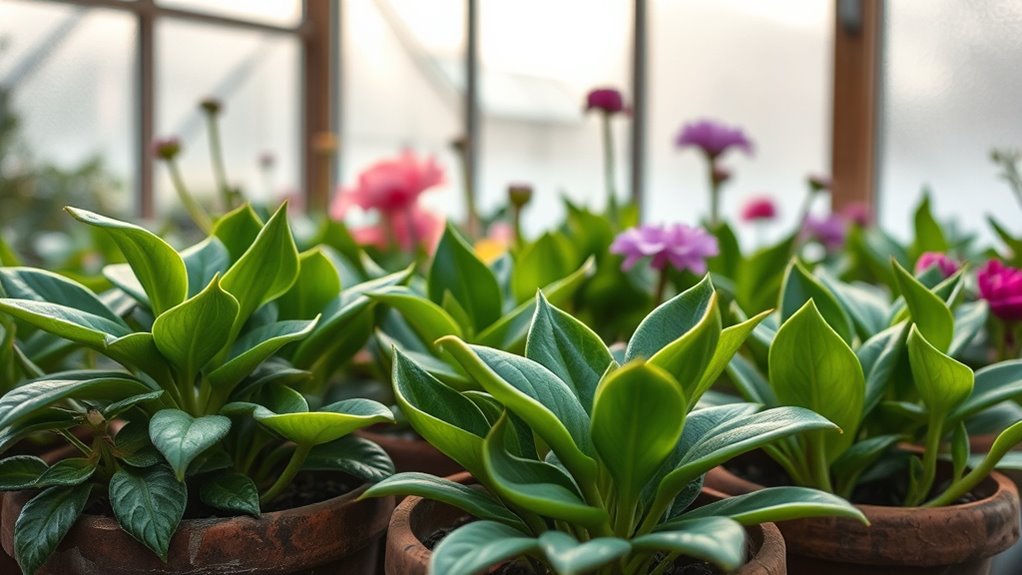To overwinter tender plants in an unheated greenhouse, focus on insulation and temperature control. Wrap vulnerable pots with bubble wrap or fleece and position plants away from cold drafts. Use thermal mats or place plants on raised benches to prevent cold soil contact. Keep temperatures above freezing, ideally around 40–50°F, by using safe heaters or heat lamps. Managing humidity and ensuring good air circulation will help prevent fungal issues. For detailed tips, keep exploring these strategies.
Key Takeaways
- Insulate the greenhouse with bubble wrap or fleece and wrap vulnerable plants to retain warmth.
- Position tender plants away from vents, drafts, and on raised surfaces with thermal mats for added protection.
- Use small space heaters or heat lamps with thermostats safely to maintain temperatures above freezing.
- Maintain proper humidity and ensure good air circulation to prevent fungal issues and promote plant health.
- Reduce watering and supplement with grow lights during short days to support plant survival and growth.

As winter approaches, it’s essential to safeguard your tender plants from the cold to guarantee they survive until spring. When you’re dealing with tender plants, hothouse cultivation isn’t always enough during the colder months. An unheated greenhouse provides a protected environment, but it still requires careful winter plant protection to make certain your plants don’t suffer from freezing temperatures, frost, or humidity issues. You need to be proactive, adjusting your approach to keep your plants healthy and thriving despite the chill outside.
First, assess your greenhouse’s insulation. Even an unheated structure can be insulated with bubble wrap or horticultural fleece to help retain heat. Wrap vulnerable pots and plants in these materials, which act as barriers against cold drafts and help maintain a more stable temperature. Position your tender plants away from the coldest spots, such as near vents or openings, and consider placing them on raised surfaces like benches or pallets to prevent cold soil contact, which can damage roots. You may also want to use thermal mats underneath pots to provide extra warmth, particularly for root zones.
Since you’re working with an unheated greenhouse, controlling humidity becomes vital. High humidity combined with cold temperatures can lead to fungal problems, so ensure good air circulation. Use fans or open vents during the day to prevent stagnant air, but close them at night to conserve heat. Keep a close eye on the temperature, aiming to keep it above freezing, ideally around 40–50°F (4–10°C), depending on the plants’ tolerance. A simple thermometer can help you monitor conditions closely, and if temperatures dip too low, consider using small space heaters with thermostats or heat lamps, but ensure they are safe for enclosed spaces and won’t pose fire risks.
Maintain proper humidity with good airflow, using fans or vents to prevent fungal issues during winter.
Watering also needs adjusting for winter. Overwatering can lead to root rot in the cold, so only water when the soil feels dry to the touch. Reduce watering frequency, but don’t let the plants become completely dry; they still need moisture to survive. Additionally, keep an eye on light levels—shorter days mean less sunlight. Supplement with grow lights if necessary to provide adequate light for photosynthesis, helping your plants stay healthy during their dormant period. Proper plant care during winter is crucial for a successful transition back to active growth in spring.
Frequently Asked Questions
How Do I Prevent Pests During Overwintering?
To prevent pests during overwintering, you should regularly inspect your plants for dormant pests and remove any visible insects or eggs. Maintain good hygiene by cleaning your greenhouse and removing plant debris. Use natural pest prevention methods like neem oil or insecticidal soap if you notice signs of pests. Quarantining new plants before introducing them also helps prevent pest spread. Consistent monitoring is key to keeping pests at bay throughout winter.
What Are the Signs of Plant Stress in Winter?
You’ll notice plant stress in winter through signs like wilting, yellowing, or leaf drop, indicating they’re struggling with winter dormancy. Frost damage may cause darkened or browning edges, and stems might appear cracked or swollen. These symptoms show your plants are reacting to cold temperatures and reduced sunlight. Keep an eye out for these signs, so you can take steps to safeguard your tender plants and ensure their health during winter.
Can I Overwinter Tropical Plants Outdoors?
Did you know that over 80% of tropical plants can survive outdoor overwintering strategies with proper care? You can overwinter tropical plants outdoors if you shield them from frost, such as by mulching or creating windbreaks. Use tropical plant care techniques like covering with frost cloths and relocating potted plants to sheltered spots. Just guarantee temperatures don’t drop below freezing, or your plants might suffer.
How Often Should I Water Tender Plants?
You should water tender plants when the soil moisture drops below the surface, usually once or twice a week, depending on humidity and temperature. Keep an eye on plant hydration by feeling the soil; it should stay slightly moist but not soggy. Overwatering can lead to root rot, so confirm proper drainage. Adjust watering frequency as needed, especially if conditions change, to maintain healthy, hydrated plants.
What Are the Best Supplemental Heating Options?
Think of your greenhouse as a cozy nest for your tender plants. To keep it warm, use supplemental heating options like electric heaters or heat mats, but don’t forget humidity control and insulation methods to prevent drafts and heat loss. These tools work together, creating a stable environment that shields your plants from winter’s chill and guarantees they thrive through cold months.
Conclusion
With the right precautions, you can successfully overwinter tender plants in your unheated greenhouse. Did you know that over 60% of gardeners report better plant survival rates when using simple insulation techniques? By keeping an eye on temperature and moisture, you’ll give your plants the best chance to thrive through winter. Don’t forget, a little effort now means a lush, healthy garden when spring arrives. Stay proactive, and your tender plants will thank you!








